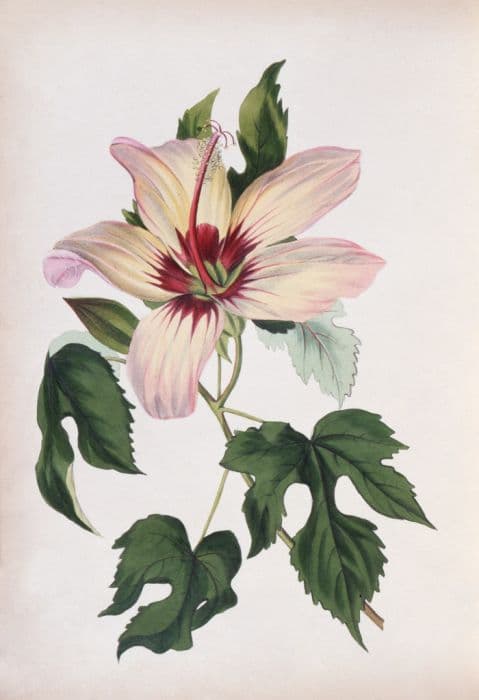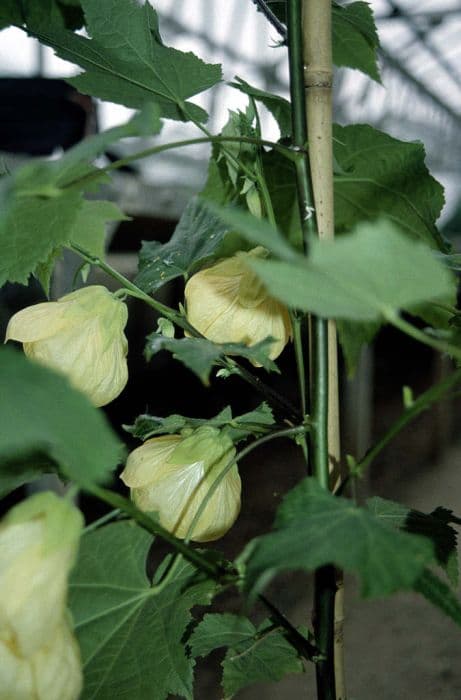Rose of Sharon Hibiscus syriacus 'Dorothy Crane'

ABOUT
The Hibiscus syriacus 'Dorothy Crane', commonly known as the Rose of Sharon, is a flowering shrub that holds a striking presence in any garden. This variety is notable for its large, trumpet-shaped flowers, which boast a delicate white hue with subtle pink flushes at their petal bases, giving them a blush-like appearance. At the center of each bloom, a prominent, dark red eye stands out, adding depth and contrast to the flower's palette. These blooms are not only attractive but are also prolific and are known for their long-lasting display that typically extends from mid-summer through the fall. The plant's foliage completes the picturesque display with three-lobed leaves that are bright green and possess a slightly glossy sheen. In the growing season, these leaves create a dense and lush canopy, providing a verdant backdrop for the profusion of flowers. After the flowering season, the leaves may sometimes take on yellow hues as they ready to drop in the fall, briefly adding a splash of autumn color before the plant settles into winter dormancy. With its romantic blossoms and vigorous growth, the Rose of Sharon 'Dorothy Crane' is a beloved choice for those looking to add a touch of classic elegance to their gardens. It can serve as a focal point when planted solitarily, or as part of a hedgerow or border when placed alongside other plants.
About this plant
 Names
NamesFamily
Malvaceae
Synonyms
Rose Of Sharon, Shrub Althea, Hardy Hibiscus, Syrian Ketmia, Rose Mallow
Common names
Hibiscus syriacus 'Dorothy Crane'.
 Toxicity
ToxicityTo humans
Rose of Sharon is generally considered to be non-toxic to humans. Ingesting parts of this plant does not typically lead to poisoning or adverse health effects.
To pets
Rose of Sharon is also considered to be relatively non-toxic to pets. While it is not commonly associated with serious illness or death, mild gastrointestinal upset could occur if a pet ingests parts of this plant. However, such instances are rare.
 Characteristics
CharacteristicsLife cycle
Perennials
Foliage type
Deciduous
Color of leaves
Green
Flower color
White
Height
8-12 feet (2.4-3.7 meters)
Spread
6-10 feet (1.8-3 meters)
Plant type
Shrub
Hardiness zones
5
Native area
Asia
Benefits
 General Benefits
General Benefits- Aesthetic Appeal: Offers large, showy flowers in late summer, providing visual interest in the garden.
- Drought Tolerance: Once established, Hibiscus syriacus is fairly drought-tolerant, requiring minimal watering.
- Pollinator-Friendly: Attracts bees and butterflies, contributing to pollination in the garden.
- Low Maintenance: Requires little pruning and is generally easy to care for.
- Cold Hardy: Can withstand cold temperatures, making it suitable for many climates.
- Long Blooming Period: Flowers last from mid-summer to early fall, providing color for an extended period.
- Versatility: Can be used in a variety of landscapes, including as a specimen plant, in hedges, or in mixed borders.
- Privacy Screen: When planted in a row, it can act as a natural privacy screen or windbreak.
- Wide Range of Colors: Comes in various shades, including blue, purple, pink, and white, allowing for diverse design choices.
 Medical Properties
Medical Properties- This plant is not used for medical purposes.
 Air-purifying Qualities
Air-purifying QualitiesThis plant is not specifically known for air purifying qualities.
 Other Uses
Other Uses- As an ingredient in jams and teas, the flowers of the Rose of Sharon can be used to add both color and a mild, cranberry-like flavor.
- Fabric dye can be made from the petals of the Rose of Sharon to create natural, soft colors for textiles.
- In some cultures, the flowers are used in religious ceremonies, symbolizing devotion and purity.
- As a natural pest repellent, the leaves can be crushed and spread around the garden to deter certain insects.
- The Rose of Sharon is also used in landscaping as a privacy hedge due to its dense growth habit.
- Papermaking crafts can incorporate the fibrous parts of the Rose of Sharon's bark into the paper blend for texture and decoration.
- Edible landscaping can include the Rose of Sharon for its attractive flowers and the fact that they are non-toxic.
- In ornamental water gardens, the Rose of Sharon can be planted near ponds to enhance the aesthetic while providing shade for aquatic life.
- The wood of the Rose of Sharon is sometimes used in small woodworking projects, like the production of musical instruments or intricate carvings.
- The plant can be used as a natural indicator of soil pH; if the plant struggles to bloom, it may suggest soil is too acidic or alkaline for its preference.
Interesting Facts
 Feng Shui
Feng ShuiThe Rose of Sharon is not used in Feng Shui practice.
 Zodiac Sign Compitability
Zodiac Sign CompitabilityThe Rose of Sharon is not used in astrology practice.
 Plant Symbolism
Plant Symbolism- Beauty: The Dorothy Crane variety of the Rose of Sharon is admired for its stunning flowers, which is why it often symbolizes beauty.
- Love: In many cultures, the Rose of Sharon represents love, possibly due to its heart-shaped petals and wide range of colors.
- Fertility: The prolific blooming nature of the plant can symbolize fertility and abundance.
- Femininity: The delicate nature of its flowers has made it a symbol for femininity and motherhood in some traditions.
- Renewal: It blooms later in the summer, which can symbolize renewal and the continuation of life.
- Survival: The Rose of Sharon is known for its hardiness and ability to withstand challenging conditions, hence it can symbolize survival.
 Water
WaterThe Rose of Sharon (the common name for Hibiscus syriacus 'Dorothy Crane') requires regular watering, particularly when it's establishing roots in the first few growing seasons. Water deeply and thoroughly, allowing the water to soak down to the root zone. Aim for about 1-1.5 gallons of water weekly during the growing season, decreasing the frequency during cooler months or when rainfall is adequate. Avoid overhead watering to prevent leaf diseases, instead focus the water at the base of the plant. During hot, dry periods, you may need to water twice a week, while in cooler, damp conditions, watering once every two weeks may suffice.
 Light
LightThe Rose of Sharon thrives best in full sun, which means it should receive at least 6 to 8 hours of direct sunlight per day. If you live in a particularly hot climate, it can benefit from light afternoon shade, but generally, the more sun, the more prolific the blooms. An east- or west-facing spot where the plant can soak up the morning or afternoon sun is ideal.
 Temperature
TemperatureThe Rose of Sharon prefers a moderate climate and is hardy in a range between about 20 to 85 degrees Fahrenheit. It can survive short periods of colder winter temperatures down to about 10 degrees Fahrenheit. The ideal growing temperature would be between 60 to 70 degrees Fahrenheit, which promotes healthy growth and flowering.
 Pruning
PruningPrune the Rose of Sharon to maintain its shape and encourage flowering. The best time to prune is late winter or early spring before new growth begins. Remove any dead, damaged, or overcrowded branches. You can also prune to shape the plant or to control its size, cutting back to just above a set of healthy buds. Pruning is typically done annually or every couple of years, depending on the growth rate and desired size.
 Cleaning
CleaningAs needed
 Soil
SoilRose of Sharon prefers well-draining loamy soil enriched with organic matter. A balanced soil mix, consisting of two parts loam, one part peat moss, and one part perlite or sand, makes an ideal medium. The pH should be slightly acidic to neutral, ranging from 6.0 to 7.5.
 Repotting
RepottingRose of Sharon, when grown in containers, should be repotted every 2-3 years. Younger plants may need repotting more frequently, annually or biennially, due to faster growth rates. Use a slightly larger pot each time to accommodate root growth.
 Humidity & Misting
Humidity & MistingRose of Sharon thrives in average humidity levels. While it does not require high humidity, it is a hardy plant that can tolerate some fluctuations in humidity. Consistent moisture in the air is beneficial but not critical for its growth.
 Suitable locations
Suitable locationsIndoor
Ensure bright light, ample space, and regular watering.
Outdoor
Full sun, well-drained soil, and protect from strong winds.
Hardiness zone
5-9 USDA
 Life cycle
Life cycleThe Rose of Sharon 'Dorothy Crane' begins its life cycle when a seed germinates in late spring after the last frost has passed, developing a root system and a shoot that emerges from the soil. As a perennial, it enters a vegetative stage, producing foliage and sturdy stems during the growing season, often reaching mature shrub form in a few years. During late summer, it enters the flowering stage, producing large, showy blooms that are white with a red center, which can attract pollinators such as bees and butterflies. After pollination, the flowers develop into seed pods that mature in autumn; these seed pods eventually release seeds, propagating the next generation. In winter, the plant enters a period of dormancy, losing leaves and ceasing growth in colder climates to conserve energy. The Rose of Sharon resumes growth the following spring, continuing its cycle, which can span several decades given optimal growing conditions.
 Propogation
PropogationPropogation time
Late spring to early summer
The Hibiscus syriacus 'Dorothy Crane', commonly known as the Rose of Sharon, is best propagated through softwood cuttings taken in late spring or early summer. This method allows for the creation of clones of the parent plant, maintaining its characteristics. To propagate by cuttings, select a healthy shoot and cut a 4-6 inch (around 10-15 cm) piece just below a leaf node. Remove the leaves from the lower half of the cutting and dip the cut end into rooting hormone. Then, insert the cutting into a pot filled with a mix of perlite and peat moss, ensuring high humidity and consistent moisture. Cuttings typically root in 4 to 8 weeks, after which they can be transferred to individual pots and grown on before planting out in the garden.









